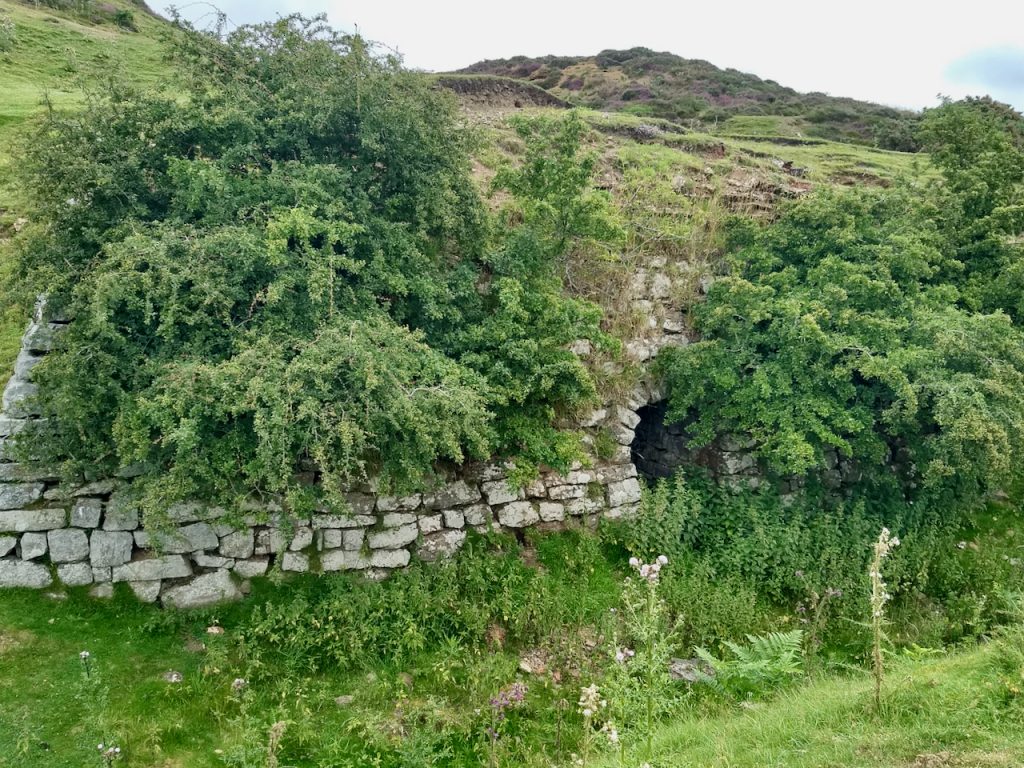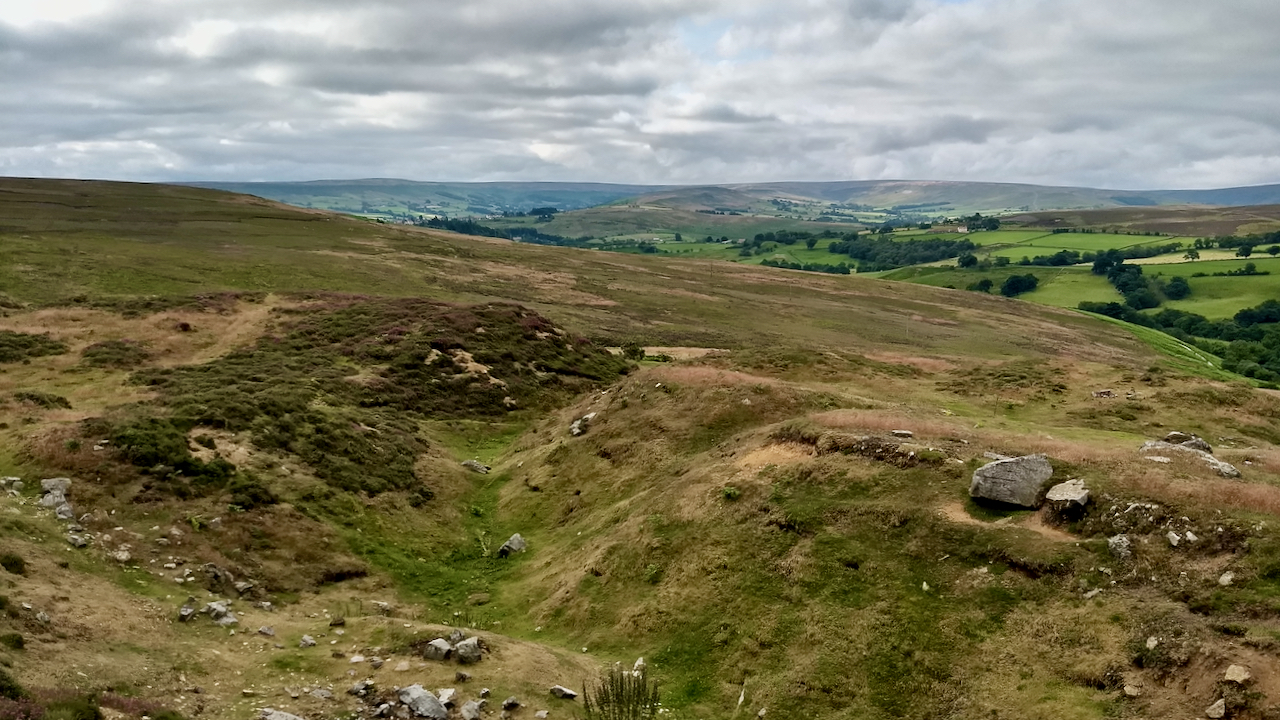I was actually a little disappointed. The pair of entrances were obscured by a large hawthorn bush and protected by vicious nettles. So I settled for a general view of the quarry above the kilns overlooking lower Commondale.

The kilns operated from 1817 to 1838 by Otley & Lightbody and exploited “a localised bed of impure limestone“1“Industrial Sites in Cleveland: supplementary list 2”. The Cleveland Industrial Archaeologist No. 36 (2016). Page 63.. As this was prior to the railway arriving in Castleton in 1861, the product, either quicklime or slaked lime, had to be transported to Cleveland by pannier train via Baysdale (I am guessing this was to avoid tolls on the Stokesley to Whitby turnpike road)2Burns, Tom Scott. “The Walker’s Guide to the Cleveland Hills”. Page 60 1993. ISBN 1-85825-009-9.. Coal for the kilns was probably supplied locally from such moorland fields as Danby, Baysdale and Rudland Rigg.
Quicklime is highly unstable reacting violently with water. It can be used to bury dead animals to prevent the spread of diseases and is also used in mining and quarrying. When carefully mixed with water, slaked lime is produced which is used in buildings and agriculture3“Historical Atlas of North Yorkshire.” Edited by Robin A Butlin. Page 184. Westbury Publishing. Reprinted 2004. ISBN 1 84103 023 6..
However, Commondale limestone was too impure for agriculture. In 1853, Dr. George Merryweather, extolling the virtues of the proposed railway wrote in the York Herald “there is a bed of limestone, 13 feet thick, with very little covering, extending three quarters of a mile. As that limestone is highly impregnated with iron, it would not answer for agriculture ; but it must be invaluable for smelting purposes.”4‘NORTH YORKSHIRE AND CLEVELAND RAILWAY’ (1853) York Herald, 08 Oct, 7, available: https://link-gale-com.ezproxy.is.ed.ac.uk/apps/doc/R3211076572/GDCS?u=ed_itw&sid=bookmark-GDCS&xid=530473b8 [accessed 23 Jul 2021].
One of the partners of Otley & Lightbody, must be Richard Otley, one of the founders of the Middlesbrough Pottery Co. in 18345“The Industrial Heart of Middlesbrough: Middlesbrough Pottery”. The Cleveland Industrial Archaeology Society Report 10 (2010). Page 12.6“Yorkshire potteries, pots and potters.” Page 79. OXLEY GRABHAM, M.A., Keeper of the York Museum. COULTAS & VOLANS LTD., PRINTERS, LITTLE STONEGATE, YORK 1916. [online] Available at: https://archive.org/stream/yorkshirepotteri00grab/yorkshirepotteri00grab_djvu.txt [Accessed 23 Jul. 2021].., a company which has also been credited with building the kilns7“The North York Moors Landscape Heritage”. Edited by D.A.Spratt and B.J.D.Harrison. Page 167. 1989. David & Charles. ISBN 0 7153 93472..
By the time of the opening of the railway as far as Castleton in 1861, the kilns had been abandoned for 23 years but it seems there was still sufficient limestone available to drive high expectations for the industrial development of Castleton and the Esk valley. “In the course of time we expect to see all along these dales extensive jet manufactories blast furnaces, rolling mills, whinstone and freestone quarries open, limekilns, pent works for making charcoal, and many other kinds of manufactures, where there are almost all the materials open to the day, and where it is next to impossible to get them at a cheaper rate.“8‘Opening of the North Yorkshire and Cleveland Railway to Castleton’ (1861) Yorkshire Gazette, 06 Apr, 5, available: https://link-gale-com.ezproxy.is.ed.ac.uk/apps/doc/JF3230900454/GDCS?u=ed_itw&sid=bookmark-GDCS&xid=a7e6f3f1 [accessed 23 Jul 2021].
I’m sure glad that didn’t come to pass.
- 1“Industrial Sites in Cleveland: supplementary list 2”. The Cleveland Industrial Archaeologist No. 36 (2016). Page 63.
- 2Burns, Tom Scott. “The Walker’s Guide to the Cleveland Hills”. Page 60 1993. ISBN 1-85825-009-9.
- 3“Historical Atlas of North Yorkshire.” Edited by Robin A Butlin. Page 184. Westbury Publishing. Reprinted 2004. ISBN 1 84103 023 6.
- 4‘NORTH YORKSHIRE AND CLEVELAND RAILWAY’ (1853) York Herald, 08 Oct, 7, available: https://link-gale-com.ezproxy.is.ed.ac.uk/apps/doc/R3211076572/GDCS?u=ed_itw&sid=bookmark-GDCS&xid=530473b8 [accessed 23 Jul 2021].
- 5“The Industrial Heart of Middlesbrough: Middlesbrough Pottery”. The Cleveland Industrial Archaeology Society Report 10 (2010). Page 12.
- 6“Yorkshire potteries, pots and potters.” Page 79. OXLEY GRABHAM, M.A., Keeper of the York Museum. COULTAS & VOLANS LTD., PRINTERS, LITTLE STONEGATE, YORK 1916. [online] Available at: https://archive.org/stream/yorkshirepotteri00grab/yorkshirepotteri00grab_djvu.txt [Accessed 23 Jul. 2021].
- 7“The North York Moors Landscape Heritage”. Edited by D.A.Spratt and B.J.D.Harrison. Page 167. 1989. David & Charles. ISBN 0 7153 93472.
- 8‘Opening of the North Yorkshire and Cleveland Railway to Castleton’ (1861) Yorkshire Gazette, 06 Apr, 5, available: https://link-gale-com.ezproxy.is.ed.ac.uk/apps/doc/JF3230900454/GDCS?u=ed_itw&sid=bookmark-GDCS&xid=a7e6f3f1 [accessed 23 Jul 2021].

Leave a Reply